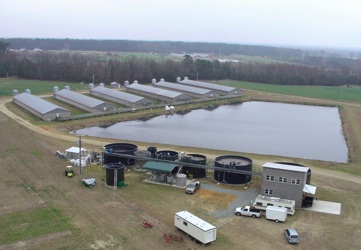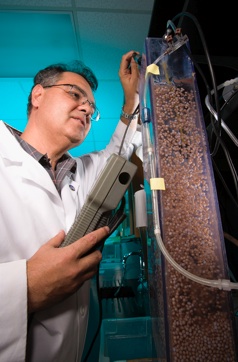
News
Wastewater irrigation effective on Bermudagrass hay
January 23, 2009 by USDA Agricultural Research Service
 January 23, 2009, Florence, S.C. – Farmers in North and South Carolina
January 23, 2009, Florence, S.C. – Farmers in North and South Carolina
already make every drop of water count by recycling livestock
wastewater for irrigation. Now Agricultural Research Service (ARS)
scientists have found ways to boost benefits from this practice even
more.
January 23, 2009, Florence, S.C. – Farmers in North and South Carolina already make every drop of water count by recycling livestock wastewater for irrigation. Now Agricultural Research Service (ARS) scientists have found ways to boost benefits from this practice even more.
 |
| In Duplin County, N.C., this full-scale wastewater-treatment system provided treated swine wastewater for the drip-irrigation study. Photo courtesy of USDA-ARS. |
The high nutrient content of livestock wastewater can limits its use for crop irrigation. In addition, spray irrigation can increase the emission of ammonia and other volatile organic compounds present in the wastewater.
ARS research leader Patrick Hunt, agricultural engineer Ken Stone and soil scientist Matias Vanotti wanted to see if subsurface drip irrigation (SDI) with pretreated swine wastewater could both eliminate emissions and increase the overall effectiveness of irrigation. Hunt, Vanotti and Stone all work at the ARS Coastal Plains Soil, Water and Plant Research Center in Florence, S.C.
They conducted a two-year study that compared bermudagrass hay crops that were irrigated via SDI. One crop was irrigated with livestock wastewater that had been pretreated to remove concentrations of ammonia, nitrogen and phosphorus. The other crop was irrigated with well water and amended with commercial fertilizer.

|
| Soil scientist Matias Vanotti monitors a bioreactor that removes nitrates from ag effluents. Photo courtesy of USDA-ARS. |
The team assessed the crops from both management systems for yield and hay biomass. They also checked soil nutrient levels and soil water nutrients.
The scientists found that crop yields were higher for bermudagrass that had been irrigated with the pretreated wastewater. They also found that bermudagrass hay yields did not vary significantly when the crops were irrigated with wastewater levels that replenished only 75 percent of the water lost to evapotranspiration.
This suggests that wastewater SDI is often effective at lower application rates. SDI irrigation with treated wastewater would also reduce the amount of water draining through the soil, which in turn would reduce the opportunity for plant nutrients to be leached below the root zone.
These results imply that SDI with treated swine wastewater provides forage crops with needed irrigation and fertilization that can equal – and even sometimes exceed – the benefits of feeding crops with commercial fertilizer.
You can read more about this research at: http://www.ars.usda.gov/is/AR/archive/jan09/clean0109.htm.